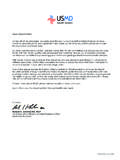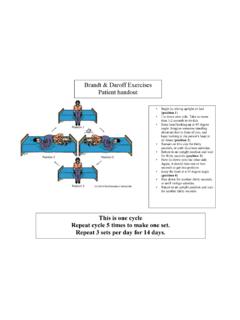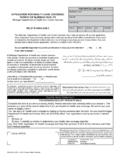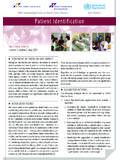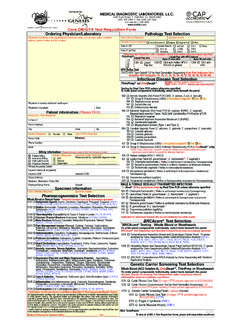Transcription of Be © er knowledge for safer care - who.int
1 Be er knowledge for safer care Human Factors in Pa ent Safety Review of Topics and Tools Report for Methods and Measures Working Group of WHO Pa ent Safety April 2009 World Health Organization (WHO), 2009 WHO/IER/ 2 World Health Organization (WHO), 2009 WHO/IER/ 3 CONTENTS EXECUTIVE SUMMARY 3 INTRODUCTION 4 FRAMEWORK 8 REVIEW OF TOPICS and TOOLS 10 1. Organizational Safety Culture 10 2. Managers Leadership 12 3. Communication 15 4.
2 Team (structures and processes) 18 5. Team Leadership (supervisors) 25 6. Situation Awareness 27 7. Decision Making 31 8. Stress 33 9. Fatigue 35 10. Work Environment 37 CONCLUSION 40 REFERENCES 41 World Health Organization (WHO), 2009 WHO/IER/ 4 EXECUTIVE SUMMARY This report was prepared for WHO Patient Safety s Methods and Measures for Patient Safety Working Group.
3 It provides a basic description of major topic areas relating to human factors relevant to patient safety, with some indication of possible tools that can be used in a healthcare workplace for measurement or training of these topics. First an explanation of the human factors approach is provided. An organising framework is presented to provide a structure for the discussion of the topics, by categorising them as follows: i) Organizational/ Managerial, ii) Team, iii) Individual, iv) Work environment. Wider social factors and the central role of the patient are also acknowledged but these aspects of the healthcare system are not explicitly covered.
4 Ten topic areas within these four categories are described: organizational culture, managerial leadership, communication, teamwork, team leadership, situation awareness, decision making, stress, fatigue, work environment. A selection of tools for education, measurement or training these human factors topics is described. Some of these may be suitable for application in developing, as well as developed, countries. Acknowledgements : We would like to thank the following for helpful comments on drafts of this report: Lucy Mitchell., Simon-Paterson-Brown, Tom Reader, Bill Runciman, Sarah Parker, George Youngson World Health Organization (WHO), 2009 WHO/IER/ 5 Human Factors in Patient Safety: Review of Topics and Tools INTRODUCTION This document presents a basic description of ten topic areas relating to organizational and human factors influencing patient safety.
5 It also identifies a selection of tools for the measurement or training of these factors which may be suitable for application in developing, as well as developed, countries. It was commissioned in 2008 by Dr Itziar Larizgoitia, WHO, following the initial meetings of the WHO Patient Safety Methods and Measures Group. The WHO Patient Safety Methods and Measures Working Group completed a series of reports on methods to measure patient safety in acute (Jeffs et al, 2009) and primary (Dovey et al, 2009) healthcare, as well as position papers on epistemology and ontology of patient safety research (Brown et al, 2008; Runciman et al under review).
6 A number of important lines of investigation emerged from these overview reports, most notably the need to understand not only organizational culture but also a range of human factors, such as managerial, team and individual characteristics that influence the behaviour of healthcare staff in relation to safe patient care. In relation to the new WHO conceptual framework for patient safety, the organizational and human factors covered here would be classed as contributing or mitigating factors (see Sherman et al, 2009). This review gives some details of how a human factors approach has been adopted in industry and then provides a brief explanation of a number of these factors, indicating their relevance to patient safety.
7 It concludes with suggestions for the wider adoption of human factors in patient safety practices. So what are human factors? What are Human Factors? The term human factors can be defined in several ways but a widely accepted definition is that of the Health and Safety Executive (HSE: UK industrial safety regulator). Human factors refer to environmental, organisational and job factors, and human and individual characteristics which influence behaviour at work in a way which can affect health and safety. A simple way to view human factors is to think about three aspects: the job, the individual and the organisation and how they impact on people s health and safety-related behaviour.
8 (HSE, 1999 p2). Human factors is usually linked closely to Ergonomics which is the application of scientific information concerning humans to the design of objects, systems and environment for human use. In World Health Organization (WHO), 2009 WHO/IER/ 6a work context, human factors research examines the environmental, organisational and job factors of humans interacting with systems, as well as the physiological and psychological characteristics which influence behaviour at work. For a more detailed explanation, see: See also the Eurocontrol (European air traffic control) human factors website.
9 Professional Bodies for Human Factors The largest of the professional human factors organisations is the Human Factors and Ergonomics Society in the USA ( ). Members come from various disciplines, such as ergonomics, psychology and engineering, as well as practitioners from industry, military and healthcare organisations. Many other countries have their own Human Factors/ Ergonomics societies, (for example, or ). The military and the aviation industry have had the longest history of applying human factors principles to enhance the design of equipment, work environments and human performance, but now many industrial sectors have specialist bodies to advise on human factors.
10 For the UK aviation industry, there is an independent Human Factors Group that is part of the Royal Aeronautical Society ( ). Similarly, the Energy Institute (a professional body for the energy sector) has a Human Factors Group ( ). In the world of healthcare, very little training in human factors is provided to staff, unlike the other safety-critical industries. In 2007, Martin Bromiley (an airline pilot whose wife died due to an anaesthetic accident which had human factors causes) established in the UK, the first Clinical Human Factors Group, which has both clinical and human factors specialists involved ( ).











